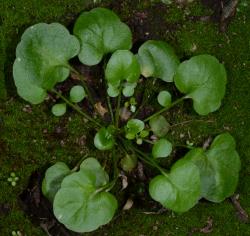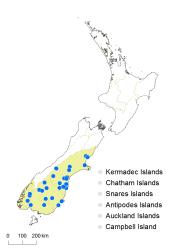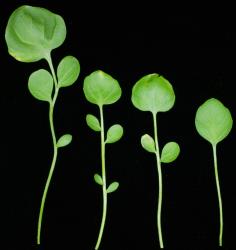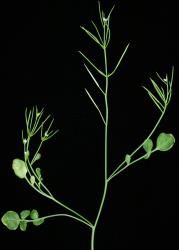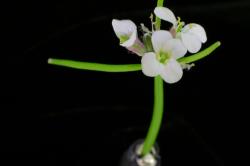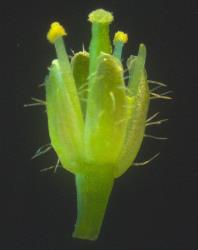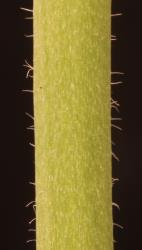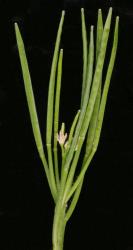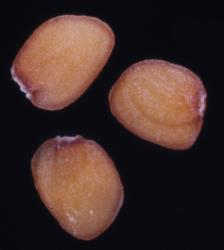Perennial herb, single rosette or with short lateral branches, stem and branches 0.6–1.2 mm diam. Leaves up to 160 mm long, pinnatifid or pinnatisect; lamina 8.0–85.0 × 3.0–40.0 mm, green, usually coriaceous, sparsely to moderately hairy or glabrate on adaxial surface, margin and petiole, glabrous or sparsely hairy on abaxial surface; terminal pinna 3.0–27.0 × 3.0–30.0 mm, simple, orbicular, orbicular-reniform to orbicular-deltoid, apex obtuse with an inconspicuous hydathode, base usually cordate, sometimes obtuse or truncate. Lateral pinnae 0–4, 2.0–19.0 × 2.0–13.0, orbicular, orbicular-rhomboid to broadly elliptic, petiolule absent or up to 1.0 mm long; petiole up to 75 mm long; hairs 0.5–0.7 mm long, spreading to patent. Cauline leaves similar to rosette leaves but smaller, narrower, with fewer lateral pinnae, pinnae bases obtuse to cuneate; terminal pinna up to 23.0 × 15.0 mm, lateral pinnae 0–2, up to 12.0 × 6.0 mm. Inflorescence with 1–9 corymbs, each corymb 2–19-flowered or flowers occasionally solitary; peduncle up to 120(–180) mm long, 0.5–2.0 mm diam. at base, spreading to ascending, glabrous or rarely hairy. Pedicels 6.0–9.0 mm long, 0.2–0.8 mm diam., glabrous or rarely hairy, ascending or divaricate. Sepals 2.2–3.0 × 1.0–1.3 mm, elliptic-oblong to narrowly elliptic-oblong, ± saccate, green or green-red; glabrous or sparsely to moderately hairy, hairs 0.6–0.7 mm long, spreading to patent; margin with a thin membranous white edge, apex obtuse with a prominent membranous white tip, base truncate. Petals 1–4 or absent; 5.5–6.5 × 2.5–3.0 mm, white, limb obovate to broadly elliptic-obovate; apex obtuse; base cuneate, tapering to a c. 1 mm-long claw. Stamens 6 on petalous flowers, 2–4 on apetalous flowers; median filaments 2–4, 2.4–3.2 mm long; lateral filaments 0–2, 2.2–2.9 mm long; anthers 0.4–0.5 mm long, cream to pale yellow, when dehiscent held at a similar height to or slightly below the stigma. Ovary 2.4–2.8 mm long, 0.4–0.4 mm diam., ± terete, green, glabrous; ovules 20–28; style 0.2–0.3 mm long, ± terete; stigma 0.3–0.4 mm diam. Siliques 13.0–26.0 × 1.1–1.3 mm, glabrous, style 0.7–0.8 mm long; valves green at maturity and when dehiscent, replum 0.4–0.5 mm wide. Seeds 1.1–1.3 mm long, 0.7–0.8 mm wide, 0.4–0.5 mm thick, orbicular-oblong to broadly oblong, light green to yellow-green; wing absent.
Cardamine grandiscapa is distinguished from C. corymbosa by its robust growth habit, larger leaves with a prominent terminal lobe, long inflorescence, and larger petals.
South Island: Canterbury, Otago, Southland, Fiordland.
Cardamine grandiscapa prefers fertile or base-rich sites and has been collected from rocky bluffs, sandstone and limestone cliffs, seepage in snow tussock, and in mānuka forest (Heenan 2017). It has been collected as a spontaneous weed in Dunedin and Christchurch gardens (e.g., CHR 616883).
Cardamine grandiscapa is assessed as having a conservation status of At Risk–Naturally Uncommon (de Lange et al. 2018).
Flowering October–February; Fruiting October–July.
Two collections from Fiordland (western Southland; CHR 636058, from Mt Luxmore, Kepler Mountains; OTA 54544, Takahē Valley, Murchison Mountains) are included in the circumscription of C. grandiscapa, but differ in having sparsely to moderately hairy pedicels and infloresence stems, whereas other plants of this species are glabrous for these characters (Heenan 2017). A further distinguishing character of the Fiordland plants is the lateral leaflets having more distinct petiolules.



